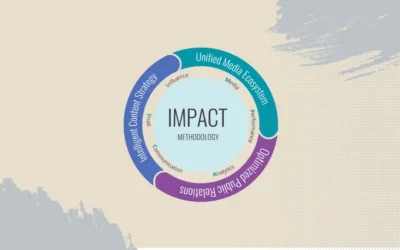Brands that achieve trust, visibility, and measurable results don’t leave it to chance. They do it through solid relationships, consistent messaging, and well-executed communication strategies. In this context, having a well-structured public relations plan is essential to build reputation, generate trust, and increase brand visibility.
Designing a PR plan goes beyond actions or timelines—it means aligning communication with business objectives, understanding audiences, and anticipating scenarios. This guide outlines the essential steps to build a public relations strategy that connects purpose, data, and messaging, positioning your brand with coherence and credibility in the spaces that truly matter.
Plan to move forward
The importance of having a strategic plan is not merely theoretical. A Prowly report reveals that 38.9% of PR professionals are prioritizing the tracking and evaluation of their efforts, showing that more organizations now understand that strategic planning and measurement go hand in hand to build trust and sustainable results.
How to build a strategic public relations plan
Discover the essential components of a PR plan—regardless of the brand’s size or sector.
1. Communication landscape analysis
Before taking action, it’s essential to understand how the brand is currently perceived, what opportunities or threats exist, and what’s being said in the media, on social media, and among stakeholders. Conducting a media audit is the starting point for a well-informed strategy aligned with reality.
2. Goal aligned with business objectives
Your goal should address a specific business need, be achievable, measurable, and relevant to strategic decision-making. The plan must include concrete objectives: building reputation, increasing brand awareness, driving visibility, or strengthening positioning.
3. Defining key audiences
Precise segmentation allows the creation of profiles based on demographics, interests, media consumption habits, and brand affinities. This enables tailored messaging and appropriate channel selection for each audience.
4. Strategic and consistent messaging
Messages should clearly communicate the brand’s value proposition and differentiators. Consistency across all touchpoints is essential, adapting tone and format depending on the channel and audience.
5. Unified Media Ecosystem
Message effectiveness also depends on the channel. Activating a unified ecosystem of owned, earned, shared, and—when necessary—paid media maximizes reach and influence at every touchpoint.
DOWNLOAD OUR FREE EBOOK
Turn your communication into tangible results.

6. Optimized content marketing
Valuable content earns attention and strengthens positioning. Applying SEO techniques to every article, post, or key asset improves organic visibility across search engines, digital platforms, and even AI-powered models.
In today’s digital ecosystem, search engines enhanced by artificial intelligence prioritize structured, contextual, and intent-driven content. Integrating AI into your optimization strategy is now essential to increase brand authority and discoverability.
7. Execution timeline
A well-defined tactical calendar includes key business dates, industry events, seasonal peaks, and internal milestones. This ensures continuity, timeliness, and relevance in every action.
8. Media mapping to amplify the brand’s voice
PR thrives on real relationships. Identifying media outlets and platforms aligned with your audience helps build long-term bonds and facilitates message distribution in trusted spaces with third-party endorsement.
9. Actionable metrics: performance indicators
Defining the right KPIs helps monitor strategy progress, evaluate real impact, and make informed decisions. Examples: media coverage, share of voice, referral web traffic, shared media engagement, or social listening insights. The key is selecting metrics aligned with objectives to turn data into action.
Measurement as part of the DNA of strategic communication
According to the 2025 Cision & PRWeek Comms Report, 96% of communication teams say they depend on data “more than ever,” proving that a PR plan must include analytical and continuous evaluation tools to translate results into concrete actions.
10. Crisis scenario planning
Every strategy should prepare for critical situations. Response protocols, spokespersons, key messages, and reaction times are defined. Active social listening enables early detection of warning signs and timely intervention before issues escalate.
11. Budget and resource allocation
A public relations plan is not just a document—it’s a strategic tool that drives reputation, builds trust, and positions brands with intention. Those leading today do so with vision, not by accident.
Brand positioning doesn’t happen by chance; it’s driven by strategy—and that requires a plan that connects with the right audiences and delivers measurable impact.
Ready to strengthen your public relations strategy with a plan that delivers real results?
FAQs
1. What are PR strategies?
PR strategies are structured plans designed to strengthen a brand’s reputation, credibility, and visibility among key audiences. They include tactics such as Optimized Public Relations (RPO), content marketing, SEO and link building, thought leadership, event amplification, corporate storytelling, influencer marketing, crisis management, and CSR programs. When integrated within a Unified Media Ecosystem (owned, earned, shared, and paid), these actions drive trust, authority, and sustainable positioning.
2. What is a public relations plan?
A public relations plan is a strategic roadmap that helps a brand communicate the right message, at the right time, to the right people. It defines communication goals, key messages, channels, and actions to build trust, visibility, and reputation. In short, it’s the map that guides every communication effort to connect with audiences and achieve real results.
3. What elements are needed to successfully implement a PR plan?
A successful PR plan combines strategy, consistency, and measurement. It includes clear objectives, deep audience understanding, authentic messaging, value-driven content optimized for search engines and AI, and a Unified Media Ecosystem (owned, earned, shared, and paid). It also requires continuous monitoring, performance analysis, and flexibility to adapt to new trends—ensuring communication drives reputation, trust, and genuine connection with audiences.
4. How can you develop an effective PR plan?
To create an effective PR plan, start by defining what you want to achieve and who you need to reach. Then, craft clear messages, choose the right channels, and create content that delivers value. Organize your actions in a calendar, measure results, and adjust based on data. The key is maintaining authentic, consistent communication aligned with business objectives and the evolving digital landscape.





